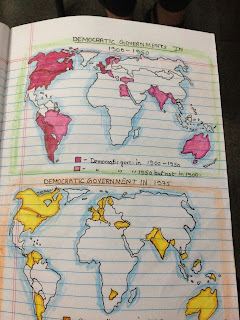Shri Shikshiyatan School in Kolkata
is an all girls private school of almost 4,000 students, which serves grades
kindergarten to 12th grade. At grade 10, students must take board
examinations in all their subjects, which determines whether they can go on to
11th and 12th grades. These board exams seem to create a
lot of stress, because I’ve seen a lot written about them in the local paper,
as well as heard the girls talk about their anxiety for the upcoming exams. In
the opening assembly, the principal mentioned the scores from the previous
year. While the school is private, the cost is very moderate, so there is range
of income levels at the school. The school has a nice big outdoor space where
students gather at the beginning of the day and which also serves as a space
for all school assemblies. The classrooms are quite small with no air
conditioning (with the exception of the computer lab) and have windows, which
open to the courtyard. The elementary grades are in a separate section of the
school and have more access to smart boards and other types of technology.
However, the smart boards in the classrooms have no internet access and
everything used on the smart board must be loaded in advance by a technician.
As a result, most classes are conducted without any technology. Some classrooms
have white boards, while others have chalkboards.
Daily routine and Academic Expectations
Students arrive to school around 8
a.m. and the first class begins at 8:30. Students have similar courses as
American schools, but the methods of teaching are quite different. For each
subject and grade, the government has written a soft covered textbook, which
contains all the material a teacher will cover in a school year. Every class
follows the textbook exactly and may write some information in an accompanying
notebook. The teacher usually reads from the textbook, students follow along
with some repetition, and then the teachers asks questions. Occasionally I’ve
seen students do a short activity in the textbook or notebook. All of the
American teachers were amazed to see the student notebooks. Almost without
exception, the students write in beautiful cursive with neatly drawn diagrams
and maps. Today I witnessed a girl pull out a short ruler to create a diagram
her teacher had put on the board. It was perfectly drawn. Students in India
usually know at least 3 languages: their local language (here it’s Bengali-see the video),
Hindi, and English. I wonder if the requirement to know Sanskrit (the script
for both Hindi and Bengali), creates a nation of beautiful script writers.
 |
| A textbook |
 |
| Student reading from the textbook in Bengali class |
|
Each classroom has a bunch of small
wooden desks jammed together to fit approximately 40 students. Some students
may have to share a chair and/or desk. The students remain in the classroom and
the teachers rotate. When students want to enter or leave a classroom, they ask
the permission of the teacher. Whenever we entered the room as guests, the entire
classroom would stand up and say “good morning, ma’am”. They did the same when
we left and when we saw them in the hallways. When students are called on to
speak, they don’t sit down again until the teacher tells them to. When I taught
my lesson, after I called on students, several students remained standing,
because I didn’t understand that I had to tell them to sit down. Without
exception, in all the classes I’ve observed, 100% of the students were focused
and attentive. However, many of the lessons are just direct teacher instruction and
require repetition and recall from the text while sitting in 90 to 100 degree
heat with just a fan whirring overhead. Often the teacher is talking the
majority of the period and a handful of students are answering questions.
Rarely, does the teacher state a clear objective for the lesson or close the
lesson with an activity that shows whether the students have learned the
material. However, the students seem much more knowledgeable than ours and are
able to answer any question their teachers ask them with amazing proficiency.
The students’ discipline, perseverance, and determination are just humbling.
School Values and Culture
When you walk down the hallways
full of inspirational posters and see the extra curricular activities in
practice, it is obvious that Shri Shikshiyatan values not just academic
success, but character. Placards around the building remind students to learn
from failure, help others, and value learning. Each morning students lead a
song over a speaker in the principal’s office, while the students and staff
stop, close their eyes, and pray. Each Tuesday, a bus of students from the
slums, come to learn from the older girls in the school. They teach them
lessons and spend time with them. The school also participates in
demonstrations and protests around important issues to the girls. Just like at
Hogwarts, the school is divided into different sections (here by color) and
they compete for points. While the classes and lessons are very adult centered,
the girls seem to easily take a leadership role among their peers.
Question: How can the U.S. create a highly disciplined and structured school culture that coexists with strong student leadership?
































